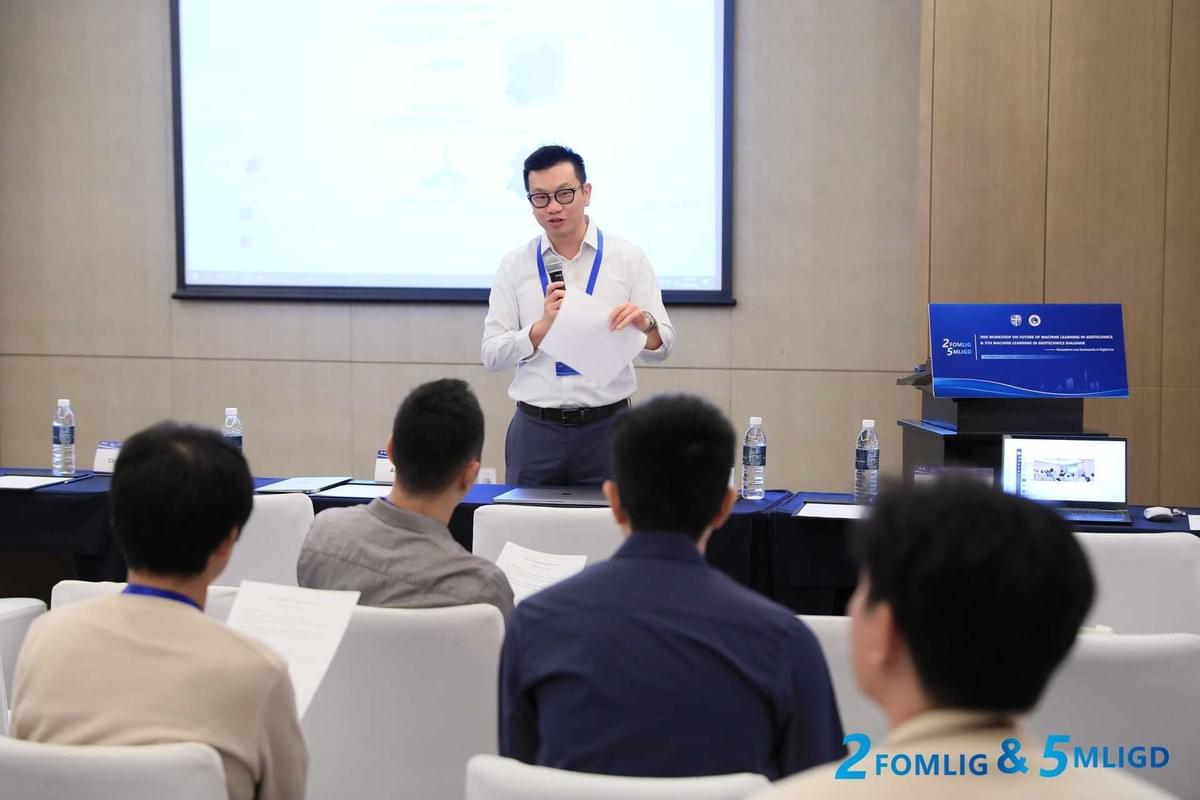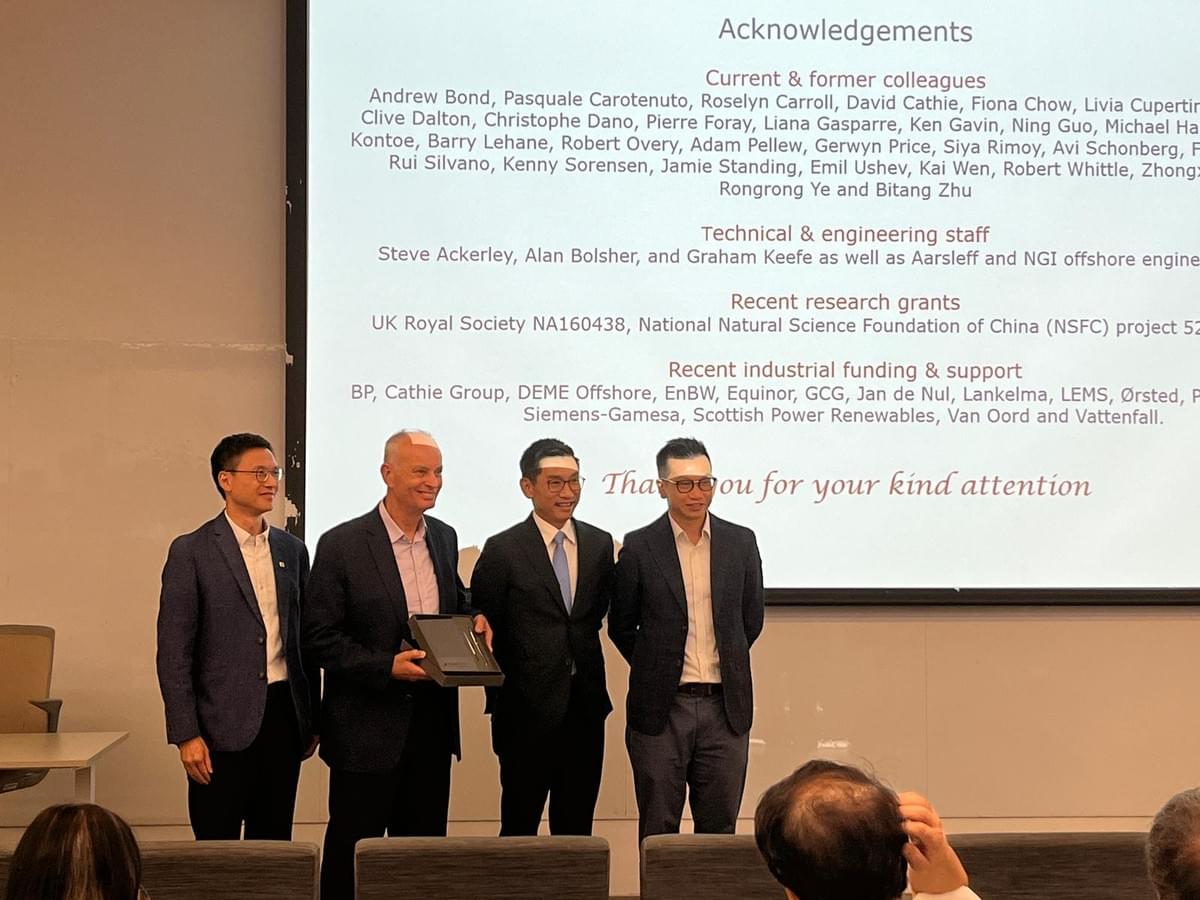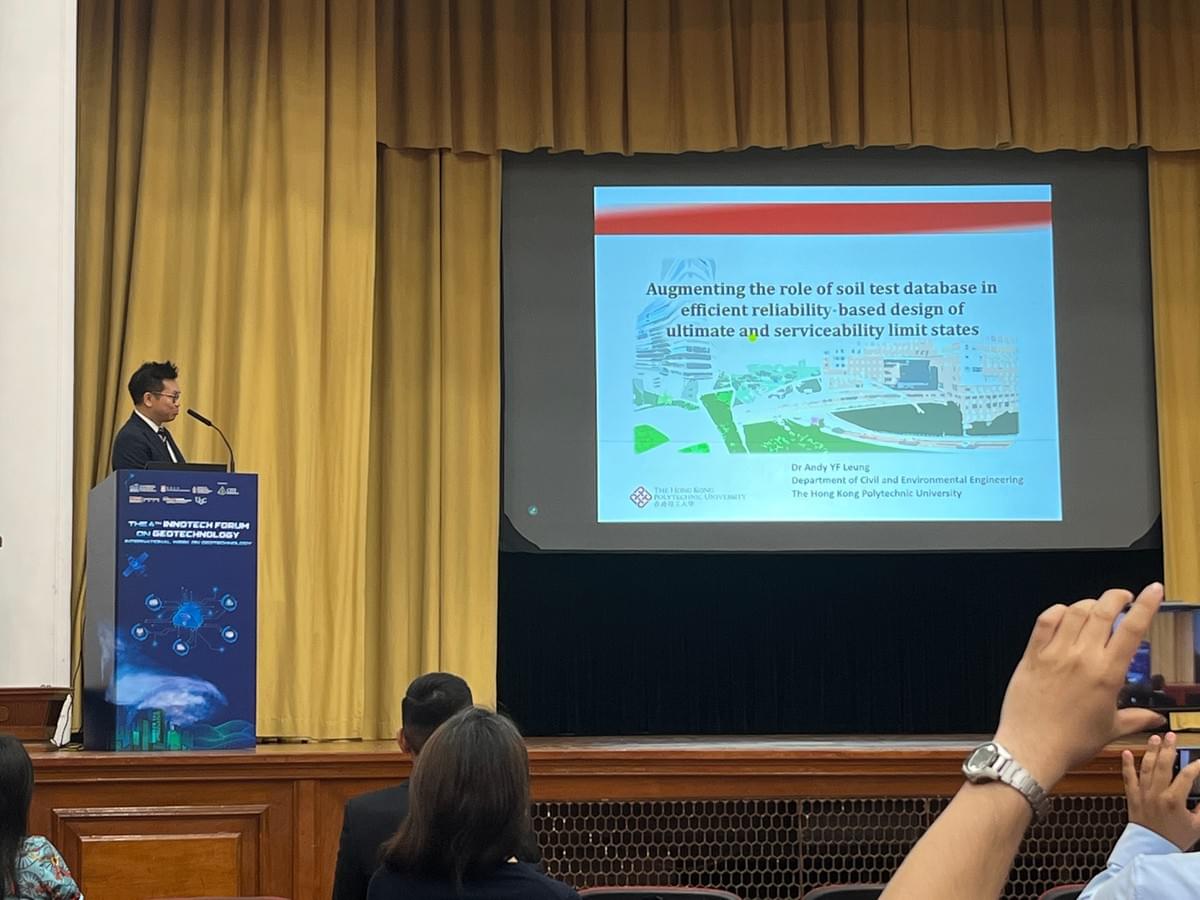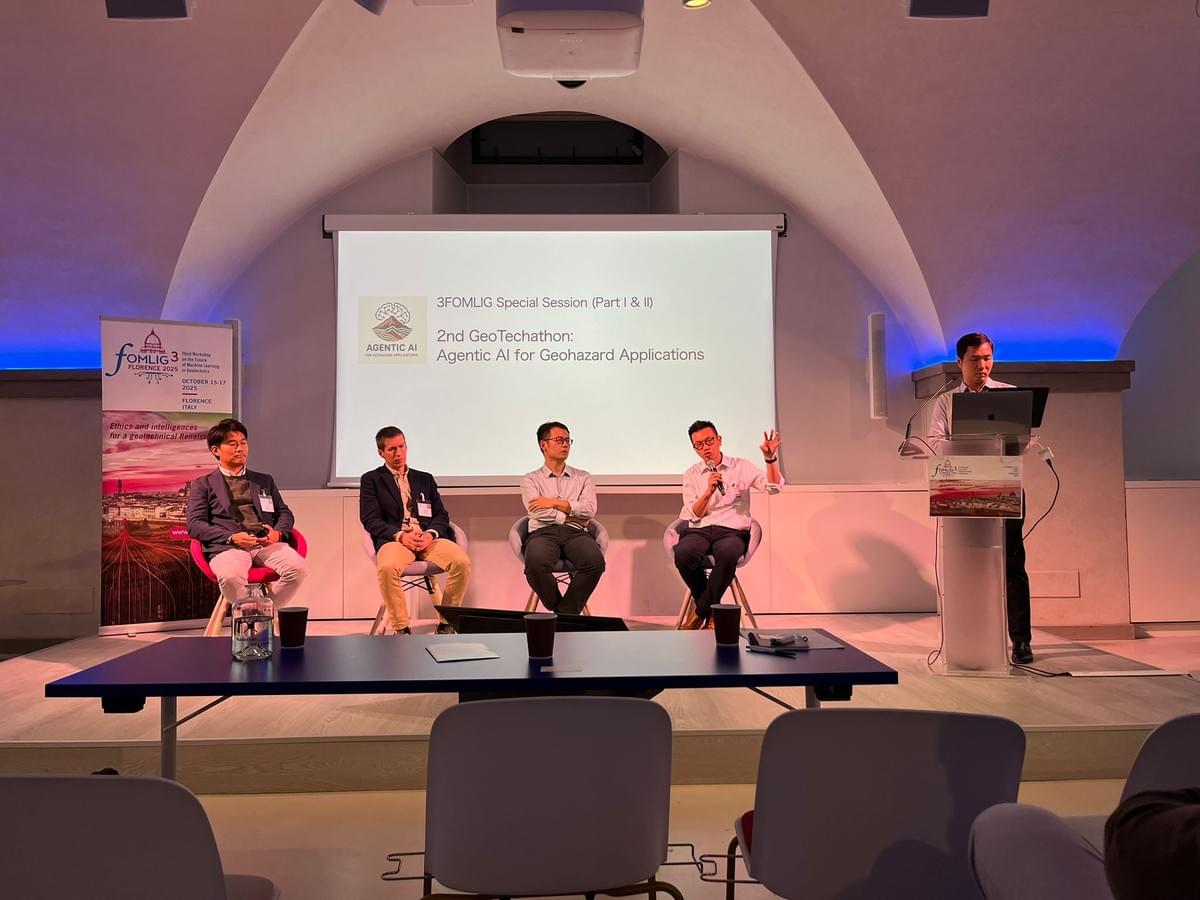
Welcome to Andy Research Group
Geotechnical Engineering @PolyU
- …
Welcome to Andy Research Group
Geotechnical Engineering @PolyU
- …
Welcome to Andy Research Group
Geotechnical Engineering @PolyU

Dr. Andy Y. F. Leung
BEng, MS, PhD (Cantab), PE, MASCE
Associate Head (Partnership) and Associate Professor
Department of Civil and Environmental Engineering
The Hong Kong Polytechnic University
President of Hong Kong Geotechnical Society (HKGES) (2022-2024)
Doctor of Philosophy in Engineering, University of Cambridge, UK
Master of Science in Engineering, University of California, Berkeley, USA
Bachelor of Engineering in Civil Engineering, University of Hong Kong
Phone: (852) 2766 6064
Fax: (852) 2334 6389
Research Interests
1. Novel Sensing Technologies for Civil Infrastructure
The Smart Geotechnology laboratory explores various aspects of soil-structure interaction problems through novel sensing techniques and investigation of strain distribution and stress mobilizations in composite structures and foundation systems. The research focuses on the use of
high-performance materials, such as high-strength steel materials, in foundation engineering and underground construction. Advanced instrumentation techniques including those with fibre optics sensing are investigated and deployed in field and laboratory studies.
Figure (left): Laboratory for development and calibration of advanced sensing equipment (right) Fibre optic sensing equipment based on Optical Frequency Domain Reflectometry, and examples of fibre optic cables for field deployment
Selected Projects
Strain developments in composite structural elements & high-strength steel in foundationsComposite structural elements, such as concrete-filled steel tube utilizes the confinements provided by steel tube to enhance the performance of concrete column, and can have wide range of applications in superstructures and substructures. The strain developments and interaction between these elements are, however, not well understood. The high-resolution optical fibre optic sensors enable the strain developments can
be accurately captured, providing a new means to understand the interaction between concrete and steel tubular structures of different geometries.The use of high-strength steel as foundation elements, such as socketed H-piles, is associated with clear benefits. With the abovementioned sensing technology, the strain developments in the steel H section, grout and surrounding geomaterials can be revealed. The available bond strengths between different components can be determined and the new data shed new insights to the behaviour of these foundation components, in order to promote their application in construction.

Figure. Examples of composite structures and H-section specimens with fibre optic sensors, and strain development patterns
Fibreoptic sensing in field investigation of soil-structure interaction
The research team actively explores opportunities for field deployment of new sensing technologies in underground construction projects, with recent examples including the monitoring of deep excavation, foundation piles, soil nails, tunnels, etc. Field instrumentation provides information on the response of underground infrastructure in complex and variable ground conditions, and helps to verify design assumptions on phenomena of soil-structure interaction.

Figure. Site deployment of fibre optic sensing to investigate soil-structure interaction in diaphragm walls (Lin et al. 2023)
2. Reliability of Geotechnical Systems
Reliability analyses aims to quantify the propagation of geotechnical uncertainty, such as uncertainty in loads and material resistances, into the uncertainty in system performance. The measure of reliability, i.e. reliability index β, is more meaningful and explicit than the factor of safety FS, because it describes safety by the number of standard deviations, separating the best estimate of FS from its defined failure value of 1.0. A popular approach to evaluate reliability index is the First-order reliability method (FORM). Our group has developed efficient spreadsheet implementation of FORM, which can be coupled with commercial software such as SLOPE/W, to handle slopes with complicated geometries and with soil nails reinforcement (Lo et al. 2022). The implementation has been applied to multiple slope cases in Hong Kong, providing practical insights on the slope reliability before and after slope improvement. Our group has also developed an efficient design chart approach to further simplify FORM analysis, which enhance reliability-based design of slopes. Utilizing the design chart approach, it is possible to reduce the amount of soil nails, at the same time improving the slope reliability.
Our group is also experienced in modelling of spatial variability of soil properties. Random field of soil properties can be simulated based on the spatial variability characteristics, which can then be applied in reliability analysis. Huang et al. (2020) coupled the conditional random field model with SLOPE/W software, with the conditional random field producing realisations that exactly match the observed data at the soil sampling locations. Lo and Leung (2017) coupled the conditional random field with finite difference modelling, to quantify the efficiency of various soil sampling strategies. Leung and Lo (2018) coupled random field model with the matrix condensation technique, which can effectively evaluate the uncertainty in differential settlement and tilting of a pile group under a superstructure loading. Mori et al. (2020) coupled the random field model with the smooth particle hydrodynamics, which can effectively evaluate the uncertainty in the runout distance during landslide.
Apart from uncertainties in loads and resistances, model uncertainty forms another important aspect in reliability analysis. Model uncertainty involves bias and randomness, where the bias indicates if the model systematically over-predicts or under-predicts the quantity in question; and the randomness indicates the variability in predictions from one prediction of that quantity to another. Our group is actively researching on characterizing and applying the model uncertainty in slope reliability analysis. This involves a through compilation of region-wide database of centrifuge slope cases, slope failure cases and soil nail pullout tests, together with probabilistic analyses on the data.
The test data serves as a valuable source on the variability of soil properties and subsurface domain, when interpreted in conjunction with the understanding of mechanics of soil and infrastructure system, could greatly assist the reliability analysis. Our group is focusing on the digitization of region-wide test database of triaxial tests and consolidation tests, which provides robust characterization on the distribution of shear strength parameters and permeability characteristics. Since a region-wide distribution may not match the distinctive site conditions, our group has formulated a hierarchical Bayesian model to narrow down the distribution of soil properties, based on the observed data of the site, in conjunction with characteristics such as particle size and site labels. Our group also is actively researching on the interpretation of region-wide test data with advanced constitutive models such as Norsand, with the aim of providing a robust distribution of model parameters for the reliability analysis of complex soil-structure interaction problems.
3. Numerical Simulation in Geotechnical Engineering
Smoothed particle hydrodynamics (SPH) and its application in sinkhole formation
SPH is a mesh-free method, which was originally applied to astrophysical phenomena and was later extended to a vast range of problems in both fluid and solid mechanics. Instead of solving the governing equations on predefined grids, SPH solves the equations based on dynamic particle connections and therefore has obvious advantages in handling problems associated with large deformations and evolving free surfaces.

The study proposed a single-layer soil-water couped SPH updates the propagation of pore pressure through combination of volumetric strain and Darcy’s law, accounting for the momentum equation, soil constitutive behavior, and the development of pore pressure at each timestep of the simulation. The proposed method is validated by analytical solutions of consolidation. Since the proposed method describes all hydraulic and mechanical information in a type of particle, thereby balancing the computation cost and calculation accuracy.
Figure. llustration of the concepts of SPH method: (Left) interactions between SPH particles and (Right) kernel function

Figure. Flowchart of the proposed method, where the boundary is dynamically detected for sinkhole formation simulation.

Figure. Failure process of sinkholes with different Young’s modulus at the same mass loss ratio R
Discrete Element Method (DEM) and its role in investigating micro soil mechanics
DEM is a popular tool for studying the displacements and forces of distinct particles and for explaining the macroscopic physical observation from the microscopic point of view. The Newton’s Law of Motion and embedded force-displacement relationship govern the behaviours of each particle. An interesting but counter-intuitive phenomenon called size segregation can be observed in shaking a can of nuts for example, where large particles go upward while small particles drop down, as shown in right figures (Jing et al., 2017).
The influence of particle shape on shear dilatancy can also be explained through DEM. Simulations with particles from angular to rounded show opposite trend of dilatancy with shape at the same void ratio and relative density. Its mechanics is explained through a series of particle pairs subject to shearing, with different shapes, packing structures, contact orientations and relative displacement modes.


Figure. (Left) Sliding induced shear dilatancy and (Right) Rotate induced shear dilatancy
Teaching
Undergraduate Courses
CSE39307 Soil Mechanics
CSE20206 Geology for Engineers
Postgraduate Courses
CSE6012 Advances in Geotechnical and Pavement Engineering
Professions
Professional Registrations & Affiliations
- President, Hong Kong Geotechnical Society (HKGES) (2022 - 2024)
- Registered Professional Engineer in California, USA (No. C74029)
- Member, American Society of Civil Engineers (ASCE)
- Member, Machine Learning and Big Data (TC309) (2019 - present)
- Member, Engineering Practice of Risk Assessment and Management (TC304) (2017 - present)
- Committee Member, Geo-engineering Education (TC306) (2015 - present)
- Committee Member, Geotechnical Division Committee, The Hong Kong Institution of Engineers (2014 - present)
- Observer, Geotechnical Division Committee, The Hong Kong Institution of Engineers (2013 - 2014)
- Executive Committee Member, Association of Geotechnical & Geoenvironmental Specialists (Hong Kong) (2014 - present)
- Co-opt Member, Association of Geotechnical & Geoenvironmental Specialists (Hong Kong) (2013 - 2014)
- Committee Member, Technical Committee for the Code of Practice for Foundations, Buildings Department (2014 - present)
Professional Experience
- July 2019 - Present Associate Professor, CEE, The Hong Kong Polytechnic University
- Apr 2013 - July 2019 Assistant Professor, CEE, The Hong Kong Polytechnic University
- Jan 2011 - Mar 2013 Project Engineer, AECOM Asia Co. Ltd., Hong Kong
- Apr 2010 - Dec 2010 Geotechnical Engineer, AECOM Asia Co. Ltd., Hong Kong
- Apr 2007 & Jul 2009 Visiting Scholar, Faculty of Civil and Environmental Engineering, Technion - Israel Institute of Technology, Israel
People
Researchers
- Geotechnical reliability
- Databases in geotechnical engineering
- Machine learning and deep learning
- Bayesian methods
Graduate Students

Yang Liu
PhD Student
- LLM-based multi-agent framework for numerical simulation
Group Graduates
1. Dr. Wenfei Liu (2018) - Characterisation of soil spatial variability and applications in ground exploration
2. Dr. Xiaoguang Xie (2019) - Geomechanical behavior of methane hydrate bearing sediments: from laboratory to field scale
3. Dr. Man Kong Lo (2019) - Effects of soil spatial variability, sampling strategy and field monitoring on geotechnical reliability
4. Dr. Lei Huang (2021) - Influences of anisotropic spatial variation of soils and sampling strategy on slope reliability evaluation
5. Dr. Xiaoyu Chen (2023) - Investigation of sinkhole formation mechanisms by single-layer soil-water coupled smoothed particle hydrodynamics method
6. Dr. Yingxu Huo (2024) - Micro-mechanical study of the particle shape effect on shearing of sands
Past Researchers
1. Dr. Maoxin Wang, 11/2022-09/2024, Geotechnical reliability and risk & earthquake engineering
2. Mr. Wenxi Meng, 09/2023-07/2024, Calibration on constitutive model parameters using centrifuge test results
Selected Publications
- Abdullah, A., Leung, Y. F., & Chan, T. M. 2025. Experimental investigation of size and cross-sectional shape effects on strain distributions in concrete-filled steel tubes. Journal of Constructional Steel Research, 235(A), 109782. https://doi.org/10.1016/j.jcsr.2025.109782
- Abdullah, A., Leung, Y. F., & Chan, T. M. 2025. Characterisation of strain distribution in concrete-filled steel tubular columns via distributed fibre optic sensing technology. Structures, 81, 110275. https://doi.org/10.1016/j.istruc.2025.110275
- Wu, S., Shi, C., Leung, Y. F., Otake, Y., Konishi, C., Zhou, M., Tao, Y., Cao, Z., & Nakamura, T. 2025. Perspectives: LLM agents reshaping the foundation of geotechnical problem-solving. Geodata and AI, 100036. https://doi.org/10.1016/j.geoai.2025.100036
- Wang, M. X., Leung, Y. F., Zhu, C., Güryuva, B., Sandıkkaya, M. A., & Ji, K. 2025. Ground-motion models for Arias intensity, cumulative absolute velocity, and duration parameters in Türkiye. Soil Dynamics and Earthquake Engineering, 196, 109440. https://doi.org/10.1016/j.soildyn.2025.109440
- Wang, M. X., Wang, G., Leung, Y. F., Li, D. Q., & Ma, S. 2025. Flexible slope displacement models for probabilistic seismic landslide hazard assessment incorporating near-fault ground-motion velocity pulse and directionality. Engineering Geology, 108313. https://doi.org/10.1016/j.enggeo.2025.108313
- Chen, X., Leung, Y. F., Mori, H., Uchida, S., & Takumi, K. 2025. Experimental and numerical investigation on contributing factors of near-surface sinkhole formation. Journal of Geotechnical and Geoenvironmental Engineering, 151(7), 04025068. https://doi.org/10.1061/JGGEFK.GTENG-12874
- Lo, M. K., Leung, Y. F., & Wang, M. X. 2025. Data-enhanced design charts for efficient reliability-based design of geotechnical systems. Structural Safety, 112, 102527. https://doi.org/10.1016/j.strusafe.2024.102527
- Wang, M. X., Leung, Y. F., & Li, D. Q. 2025. Neural network-assisted generic predictive models of safety factor and yield acceleration for seismic slope stability and displacement assessments. Canadian Geotechnical Journal, 62, 1-19. https://doi.org/10.1139/cgj-2024-0106
- Wang, M. X., Leung, Y. F., & Lo, M. K. 2025. Incorporating region-variability of model bias into liquefaction-triggering procedures for sandy and gravelly soils through BUS-powered hierarchical Bayesian updating. Canadian Geotechnical Journal. 62, 1-24. https://doi.org/10.1139/cgj-2024-0059
- Lo, M. K., Leung, Y. F., Chan, C. L., & Sze, E. H. Y. 2025. Reappraisal of reliability of a slope through hybridisation of regional and site-specific soil shear strength information. Canadian Geotechnical Journal, 62, 1-24. https://doi.org/10.1139/cgj-2023-0633
- Wang, M. X., & Leung, Y. F. 2024. Amplification factors of intensity measures for site-specific PSHA using spectrally equivalent pulse-like and non-pulse-like ground motion records. Soil Dynamics and Earthquake Engineering, 187, 108970. https://doi.org/10.1016/j.soildyn.2024.108970
- Yin, J. H., Chen, W. B., Wu, P. C., Leung, Y. F., Yin, Z. Y., Cheung, C. K., & Wong, A. H. 2024. Field study of a sustainable land reclamation approach using dredged marine sediment improved by horizontal drains under vacuum preloading. Journal of Geotechnical and Geoenvironmental Engineering, 150(11), 04024114. https://doi.org/10.1061/JGGEFK.GTENG-12632
- Wang, M. X., Leung, Y. F., Wang, G., & Zhang, P. 2024. Semiempirical predictive models for seismically induced slope displacements considering ground motion directionality. Journal of Geotechnical and Geoenvironmental Engineering, 150(9), 04024080. https://doi.org/10.1061/JGGEFK.GTENG-11930
- Chen, X., Leung, Y. F., Mori, H., Uchida, S., & Takumi, K. 2024. Single-layer soil-water coupled SPH method and its application to sinkhole simulation. Acta Geotechnica, 19(2), 991-1018. https://doi.org/10.1007/s11440-023-02063-4
- Leung, Y. F., Phoon, K. K., Xiao, T., Shuku, T., & Ching, J. 2024. Report for ISSMGE TC309/TC304/TC222 and ASCE Geo-Institute Risk Assessment and Management Committee Fourth Machine Learning in Geotechnics Dialogue on “Machine Learning Supremacy Projects”: 5 December 2023, Okayama Convention Center, Okayama, Japan. Georisk: Assessment and Management of Risk for Engineered Systems and Geohazards, 18(1), 304–313. https://doi.org/10.1080/17499518.2024.2316879
- Lin, S. Q., Tan, D. Y., Leung, Y. F., Yin, J. H., Li, I., Sze, H. Y., Lo, L. C., Kan, H. S., Wong, C. W., & Chan, Y. M. 2023. Fiber-optic monitoring of a twin circular shaft excavation: Development of circumferential forces and bending moments in diaphragm walls. Journal of Geotechnical and Geoenvironmental Engineering, 149(12), 04023117. https://doi.org/10.1061/JGGEFK.GTENG-11211
- Huo, Y. X., Leung, Y. F., & Kwok, C. Y. 2023. Micro-mechanical perspective on the role of particle shape in shearing of sands. Canadian Geotechnical Journal, 60(10), 1515-1531. https://doi.org/10.1139/cgj-2022-0270
- Phoon, K. K., Cao, Z. J., Ji, J., Leung, Y. F., Najjar, S., Shuku, T., Tang, C., Yin, Z. Y., Ikumasa, Y., & Ching, J. 2022. Geotechnical uncertainty, modeling, and decision making. Soils and Foundations, 62(5), 101189. https://doi.org/10.1016/j.sandf.2022.101189
- Lo, M. K., Leung, Y. F., & Ku, T. 2021. Variability response function approach for foundation reliability. Probabilistic Engineering Mechanics, 64, 103129. https://doi.org/10.1016/j.probengmech.2021.103129
- Huang, L., & Leung, Y. F. 2021. Reliability assessment of slopes with three-dimensional rotated transverse anisotropy in soil properties. Canadian Geotechnical Journal, 58(9), 1365-1378. https://doi.org/10.1139/cgj-2019-0611
- Zhang, W., Ching, J., Goh, A. T., & Leung, Y. F. 2021. Big data and machine learning in geoscience and geoengineering: Introduction. Geoscience Frontiers, 12(1), 327-329. https://doi.org/10.1016/j.gsf.2020.05.006
- Zhou, M., Shadabfar, M., Huang, H., Leung, Y. F., & Uchida, S. 2020. Meta-modelling of coupled thermo-hydro-mechanical behaviour of hydrate reservoir. Computers and Geotechnics, 128, 103848. https://doi.org/10.1016/j.compgeo.2020.103848
- Mori, H., Chen, X., Leung, Y. F., Shimokawa, D., & Lo, M. K. 2020. Landslide hazard assessment by smoothed particle hydrodynamics with spatially variable soil properties and statistical rainfall distribution. Canadian Geotechnical Journal, 57(12), 1953-1969. https://doi.org/10.1139/cgj-2019-0601
- Huang, L., Cheng, Y. M., Leung, Y. F., & Li, L. 2019. Influence of rotated anisotropy on slope reliability evaluation using conditional random field. Computers and Geotechnics, 115, 103133. https://doi.org/10.1016/j.compgeo.2019.103133
- Zheng, F., Leung, Y. F., Zhu, J. B., & Jiao, Y. Y. 2019. Modified predictor‐corrector solution approach for efficient discontinuous deformation analysis of jointed rock masses. International Journal for Numerical and Analytical Methods in Geomechanics, 43(2), 599-624. https://doi.org/10.1002/nag.2881
- Lo, M. K., & Leung, Y. F. 2019. Bayesian updating of subsurface spatial variability for improved prediction of braced excavation response. Canadian Geotechnical Journal, 56(8), 1169-1183. https://doi.org/10.1139/cgj-2018-0409
- Liu, W. F., & Leung, Y. F. 2018. Spatial variability of saprolitic soil properties and relationship with joint set orientation of parent rock: Insights from cases in Hong Kong. Engineering Geology, 246, 36-44. https://doi.org/10.1016/j.enggeo.2018.09.015
- Leung, Y. F., & Lo, M. K. 2018. Probabilistic assessment of pile group response considering superstructure stiffness and three-dimensional soil spatial variability. Computers and Geotechnics, 103, 193-200. https://doi.org/10.1016/j.compgeo.2018.07.010
- Leung, Y. F., Liu, W., Li, J. S., Wang, L., Tsang, D. C., Lo, C. Y., Leung, M. T., & Poon, C. S. 2018. Three-dimensional spatial variability of arsenic-containing soil from geogenic source in Hong Kong: Implications on sampling strategies. Science of the Total Environment, 633, 836-847. https://doi.org/10.1016/j.scitotenv.2018.03.049
- Liu, W. F., & Leung, Y. F. 2018. Characterising three-dimensional anisotropic spatial correlation of soil properties through in situ test results. Géotechnique, 68(9), 805-819. https://doi.org/10.1680/jgeot.16.P.336
- Jing, L., Kwok, C. Y., Leung, Y. F., Zhang, Z., & Dai, L. 2018. Runout scaling and deposit morphology of rapid mudflows. Journal of Geophysical Research: Earth Surface, 123(8), 2004-2023. https://doi.org/10.1029/2018JF004667
- Leung, Y. F., Liu, W., Lei, Y., & Hsu, S. C. 2018. Quantifying cost-effectiveness of subsurface strata exploration in excavation projects through geostatistics and spatial tessellation. Automation in Construction, 90, 243-252. https://doi.org/10.1016/j.autcon.2018.02.032
- Lo, M. K., & Leung, Y. F. 2018. Reliability assessment of slopes considering sampling influence and spatial variability by Sobol’ sensitivity index. Journal of Geotechnical and Geoenvironmental Engineering, 144(4), 04018010. https://doi.org/10.1061/(ASCE)GT.1943-5606.0001852
- Lo, M. K., & Leung, Y. F. 2017. Probabilistic analyses of slopes and footings with spatially variable soils considering cross-correlation and conditioned random field. Journal of Geotechnical and Geoenvironmental Engineering, 143(9), 04017044. https://doi.org/10.1061/(ASCE)GT.1943-5606.0001720
- Jing, L., Kwok, C. Y., & Leung, Y. F. 2017. Micromechanical origin of particle size segregation. Physical Review Letters, 118(11), 118001. https://doi.org/10.1103/PhysRevLett.118.118001
- Leung, Y. F., Klar, A., Soga, K., & Hoult, N. A. 2017. Superstructure–foundation interaction in multi-objective pile group optimization considering settlement response. Canadian Geotechnical Journal, 54(10), 1408-1420. https://doi.org/10.1139/cgj-2016-0498
- Liu, W. F., Leung, Y. F., & Lo, M. K. 2017. Integrated framework for characterization of spatial variability of geological profiles. Canadian Geotechnical Journal, 54(1), 47-58. https://doi.org/10.1139/cgj-2016-0189
- Jing, L., Kwok, C. Y., Leung, Y. F., & Sobral, Y. D. 2016. Characterization of base roughness for granular chute flows. Physical Review E, 94(5), 052901. https://doi.org/10.1103/PhysRevE.94.052901
- Uchida, S., Xie, X. G., & Leung, Y. F. 2016. Role of critical state framework in understanding geomechanical behavior of methane hydrate‐bearing sediments. Journal of Geophysical Research: Solid Earth, 121(8), 5580-5595. https://doi.org/10.1002/2016JB012967
- Jing, L., Kwok, C. Y., Leung, Y. F., & Sobral, Y. D. 2016. Extended CFD–DEM for free‐surface flow with multi‐size granules. International Journal for Numerical and Analytical Methods in Geomechanics, 40(1), 62-79. https://doi.org/10.1002/nag.2387
- Leung, Y. F., Soga, K., Lehane, B. M., & Klar, A. 2010. Role of linear elasticity in pile group analysis and load test interpretation. Journal of Geotechnical and Geoenvironmental Engineering, 136(12), 1686-1694. https://doi.org/10.1061/(ASCE)GT.1943-5606.0000392
- Leung, Y. F., Klar, A., & Soga, K. 2010. Theoretical study on pile length optimization of pile groups and piled rafts. Journal of Geotechnical and Geoenvironmental Engineering, 136(2), 319-330. https://doi.org/10.1061/(ASCE)GT.1943-5606.0000206
- Klar, A., & Leung, Y. F. 2009. Simple energy-based method for nonlinear analysis of incompressible pile groups in clays. Journal of Geotechnical and Geoenvironmental Engineering, 135(7), 960-965. https://doi.org/10.1061/(ASCE)GT.1943-5606.0000002
More Publications: Google Scholar; Research Gate
PhD and RA Position
Openings:
Hong Kong PhD Fellowship
This Fellowship scheme offered by HK Research Grants Council aims to recruit high-calibre students from around the world to undertake their PhD studies in Hong Kong. We invite expressions of interest from graduates with proven record of academic excellence, research ability, and good communication skills. The awardees will be provided with a 3-year tuition scholarship, a annual stipend of HK$340,800 (~US$43,692) and Conference and Research related travel allowance of HK$14,200 (~US$1,820) per year. More information can be found here.
University PhD Studentship
Outstanding individuals with a strong commitment to original research are encouraged to apply. Applicants should have satisfactory scores in TOEFL (internet-based: 80 or above) or IELTS (6.5 or above), and demonstrate appropriate background in areas of geotechnical engineering or a related field. The admission requirements can be found here. Excellent English communication skills, team-working abilities and self-motivation are essential. PhD studentship (HK$19,220 per month, subject to review) will be offered to successful applicants. More information can be found here.
Research Assistant
Initial appointments will be available for 6-12 months, with possible extension depending on satisfactory progress and mutual agreement. Successful applicants are expected to hold a Bachelor degree in civil engineering, while candidates with a Master degree in geotechnical engineering will be preferred. Salary will be commensurate with qualifications and experience, and applicants should state their current and expected salary in the application.
Application:
Interested candidates may contact me with your English CV, transcripts and Language test through email.
Activity
Group meeting





Field trip




Seminar/workshop/conference








Christmas lunch 2023


Contact us




































